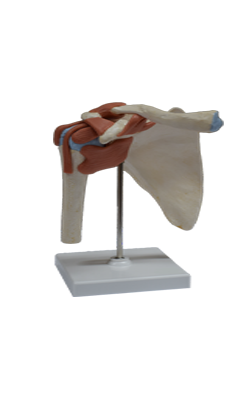Main Model

Anterior : Ligament coraco-acromial

Ligaments of Glenohumeral Joint
The glenohumeral ligaments, which strengthen the anterior aspect of the joint capsule and the coracohumeral ligament, which strengthens the joint capsule superiorly, are intrinsic ligaments - that is, part of the fibrous layer of the joint capsule.
The glenohumeral ligaments are three fibrous bands, evident only on the internal aspect of the capsule, that reinforce the anterior part of the joint capsule. These ligaments radiate laterally and inferiorly from the glenoid labrum at the supraglenoid tubercle of the scapula and blend distally with the fibrous layer of the capsule as it attaches to the anatomical neck of the humerus.
The coracohumeral ligament is a strong broad band that passes from the base of the coracoid process to the anterior aspect of the greater tubercle of the humerus.
The transverse humeral ligament is a broad fibrous band that runs more or less obliquely from the greater to the lesser tubercle of the humerus, bridging over the intertubercular sulcus. This ligament converts the groove into a canal, which holds the synovial sheath and tendon of the biceps brachii in place during movements of the glenohumeral joint.
The coraco-acromial arch is an extrinsic, protective structure formed by the smooth inferior aspect of the acromion and the coracoid process of the scapula, with the coraco-acromial ligament spanning between them. This osseoligamentous structure forms a protective arch that overlies the humeral head, preventing its superior displacement from the glenoid cavity. The coraco-acromial arch is so strong that a forceful superior thrust of the humerus will not fracture it; the humeral shaft or clavicle fractures first.
* CORACOID PROCESS + CORACO-ACROMIAL LIGAMENT + ACROMION = CORACO-ACROMIAL ARCH
Transmitting force superiorly along the humerus (e.g., when standing at a desk and partly supporting the body with the outstretched limbs), the humeral head presses against the coraco-acromial arch. The supraspinatus muscle passes under this arch and lies deep to the deltoid as its tendon blends with the joint capsule of the glenohumeral joint as part of the rotator cuff.
Movement of the supraspinatus tendon, passing to the greater tubercle of the humerus, is facilitated as it passes under the arch by the subacromial bursa, which lies between the arch superiorly and the tendon and tubercle inferiorly.